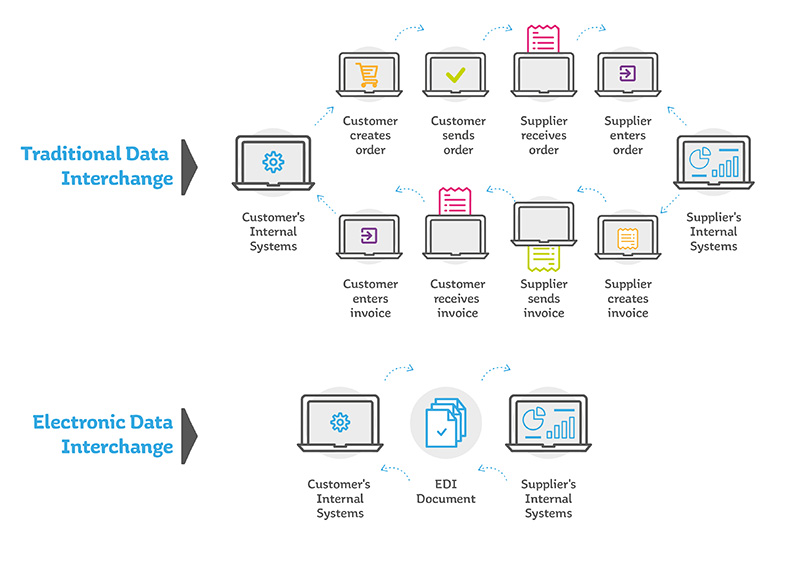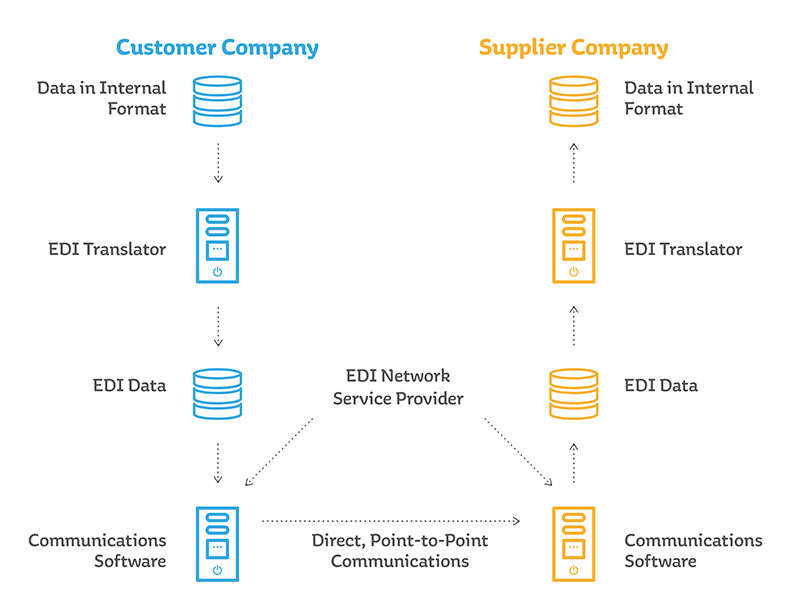EDI (Electronic Data Interchange) is the exchange of documents in a standard electronic format between two business partners, from computer to computer.
In this post, you will find the answers to all of your EDI questions:
How do you define EDI?
Electronic Data Interchange replaces traditional means of communication such as post, faxes and emails, therefore improving and optimising the flow of information between two companies, in terms of time, cost and quality.
INSEE[1] (the French National Institute of Statistics and Economic Studies) offers a fairly comprehensive definition of the concept: "The electronic data interchange (EDI) is a technique that replaces physical exchanges of documents between companies (orders, invoices, delivery slips etc.) with exchanges, according to a standardised format, between computers connected through specialised connections or through a (private) value-added network (VAN). The data are structured according to reference international technical standards (e.g. Edifact[2])."
Traditional data exchange vs. EDI

Who is EDI aimed at?
Any company can use EDI to exchange business documents with its partners (suppliers, customers, banks etc.), as long as their partners are able to interpret this data and integrate it into their own information system in an automated manner.
How does EDI work?
All business documents can be digitalised using EDI, such as order forms, purchase orders, mandates, invoices, payment documentation, shipping notices, customs documents and inventory analyses.
However, these documents must follow a standard format so that computers can process this flow of information automatically. Several standards (XML and OCI for messages relating to purchase requests, orders and order confirmations etc.) are available to ensure standardisation, each of which come in several versions. Before sending any documents, business partners must agree on the format (standard and version) they wish to use.
Once a format is decided upon, the process follows three main steps:
1. Prepare the documents
First, the information required to create the document needs to be gathered and organised.
2. Translate the documents into the correct format
Next, the internal document must be converted into the defined format. To do this, you can either purchase and use your own EDI translation software or utilise a service provider.
3. Connect and send the documents
Your business documents are ready to go! There are multiple ways to send them to your business partner:
- Direct connection using a secure protocol, also known as Point-to-Point EDI
- Connection via an EDI network provider
The EDI sending process

The three main benefits of EDI
By digitalising and optimising the exchange of business documents, EDI enables you to:
- Reduce costs
Processing costs, particularly labour costs, decrease considerably as a result of automated exchanges. For example, the average cost of manually processing invoices is nearly €26.70 per invoice. However, this is reduced to just over €3.10 per invoice if they are processed electronically.[3]
- Increase efficiency
The automation and digitalisation of exchanges significantly reduce human intervention. As a result, using EDI reduces errors and optimises the processing speed, while also improving the security and traceability of exchanges. The average transaction processing time is reduced from five days (paper-based) to less than one hour (using EDI)[4].
- Improve business relationships
A reduction in errors and delays, the adoption of a common language, faster communication and reduced costs — all of these factors help to strengthen relationships between current and future business partners.







